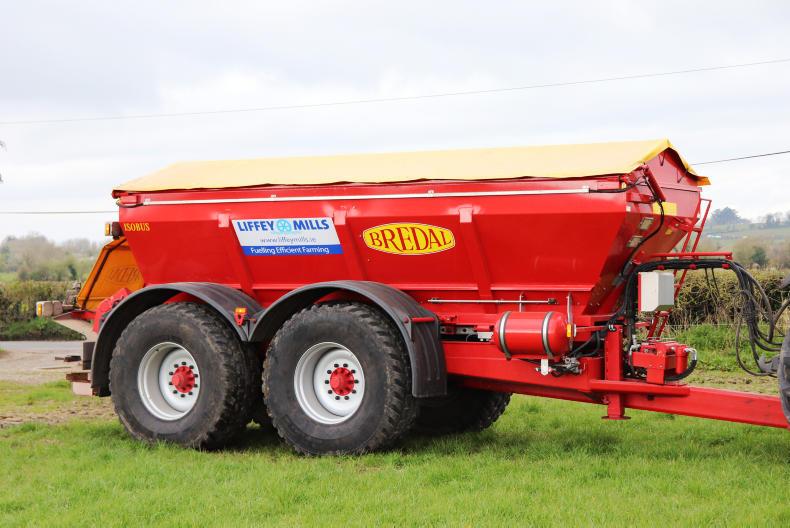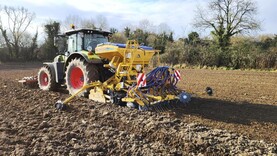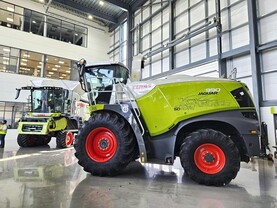Danish spreader manufacturer Bredal has had a strong presence within Irish contracting fleets for many years now. It offers two trailed spreader series. Its F series is designed solely for high-precision fertiliser spreading, while the K series can spread both fertiliser and lime.
Declan Gilligan, based in Eyrecourt, Co Galway, works on behalf of Liffey Mills Banagher, spreading bulk fertiliser and hauling meal throughout the winter period. Declan also does baling and reseeding work.

Conor Gilligan who operates the spreader for Declan Gilligan, and Daniel Hogan from Liffey Mills .
During busy periods, two fertiliser spreaders are contracted in to spread for Liffey Mills. Over the past number of years, Liffey’s Banagher branch has seen an uptake in customers opting for contract spreading service when purchasing fertiliser. Daniel Hogan from Liffey Mills explained that this is partly due to the strong working relationship between Declan and Liffey Mills in providing a fast, reliable service using the latest technology available on the market.
Up until recently, Declan operated two single-axle Bredal K85 spreaders but, with the increasing demand for contract bulk spreading, Declan recently upgraded one of his K85 spreaders to a higher-capacity tandem-axle K135. Since taking delivery of the new spreader two weeks ago in March, Conor has spread just over 420t of fertiliser with the machine.
The spreader is fully spec’d from top to bottom. Hydraulic drive eliminates the need for PTO. The spreader runs off the tractor’s hydraulic oil supply, which was part of Declan’s reason for purchasing a new Claas Axion 830 Cematic to pull the spreader as well as the increased weight and horsepower to deal with the larger spreader. Conor said this allows for spreading at much lower rpm (1,600), as the tractor is capable of supplying the spreader with the 130l/min that it requires to operate properly.

The Bredal K1365 spreader has the capacity to carry 14t of fertiliser.
Hydraulic drive allows for more precise control of the rear discs as individual disc speed is preset for headland runs. The headland function can then be engaged or disengaged while moving. It has the ability to spread headlands in either direction, unlike the unidirectional border control of PTO-driven machines.
Fine control of disc speeds means the spreader is capable of GPS section control, broken up into 12 sections that each automatically shut off when encountering an overlap in application.
Tandem axle
The body of the spreader is seated on a rear-steering bogie axle equipped with parabolic springs and air over hydraulic brakes. Conor said the spreader is very manoeuvrable due to its passively steering rear axle, further noting its ability to travel and fit through places the smaller single-axle K85 could: “The spreader’s travelling ground every bit as good as the K85, if not better in fact.”
Fitted with 650/65 R30.5 Michelin CargoXbib tyres, the spreader has a much larger footprint than a single-axle machine, reducing compaction. This leaves Conor able to run the tyres at lower ground pressures of 16psi compared to 19/20psi on the K85 spreader, even though carrying 3.5t to 4t more when full. The gross weight of the tractor and spreader fully loaded is 32t.
Hopper
Declan’s K135 is the first tandem-axle spreader manufactured by Bredal to be fitted with dynamic weigh-cells, Conor noted. These weigh-cells allow the spreader to calibrate every 15 seconds, ensuring complete accuracy in reading both the spreader’s remaining quantity and the desired application rate. The spreader continually adjusts as it constantly reads the weight at which the fertiliser leaves the hopper, comparing this to the desired application rate. It then increases or decreases fertiliser flow rate accordingly.
Declan has had the spreader retrofitted with a full stainless steel divide manufactured by John Maher in Birr, Co Offaly. This means the spreader can now carry two different fertiliser types – compound and urea. The rear section has a 7.5t capacity and the front has a 6.5t capacity. Fertiliser in the rear will automatically be spread first. This leaves the weight up front on the drawbar, allowing the tractor to grip better than it would if the front section was spread first. Opening and closing of the front section is done manually from the side of the spreader. Conor said having the capabilities to carry two fertiliser types reduces time spent travelling, as he now can carry all at once.
The spreader has a hydraulic hopper cover and a hydraulic stand to speed up attaching and detaching from the tractor.
In the cab
The cab has four displays. Conor uses the tractor’s display terminal to monitor oil flow and all of the tractor’s other operations, while GPS is set up and controlled using the Claas S10 Isobus terminal. The spreader can be controlled by Isobus (S10 terminal) or optionally using the Topcon X35 terminal. Conor said they opted for the Topcon screen so that the spreader would be compatible with other tractors in the fleet. Multiple terminals allow Conor to monitor the tractor and spreader without having to switch between screens. A camera is fitted above the discs, allowing live monitoring of fertiliser flow out to the discs and to monitor discs in motion.
Having used GPS on the spreaders for the past 10 years, Declan made the decision when buying the Claas Axion 830 for the tractor to be fitted with auto-steer. This ensures greater efficiency and utilisation of the spreader’s capabilities, spreading to its set width all the time.
The spreader can spread to 36m but most compound fertiliser spreading is done at 24m and urea-based fertilisers at 18m.
All customers fields are saved on the terminal so, upon entering a field, data such as preset AB lines and previous application rates can be called up instantly.
Savings
Conor and Declan are impressed with the savings being made with the new tractor and spreader. The Claas Axion 830’s Cmatic gearbox alone is saving 2l/hr on diesel due the fact once up to 50km/h on the road the engine cuts back to 1,600rpm as well as reduced rpm when spreading, compared to the old Claas Arion 650 Cebis and PTO-driven K85 spreader setup. Savings are also reaped from the increase in spreader capacity because fewer journeys have to be made to refill the spreader.
Conor said this is a significant benefit because their customer base covers a large area. Conor said he can spread between of 45t and 50t per day with the new setup compared to 30t per day with the older K85 spreader. This increase is a big saving.
Machine specification
Model: Bredal K135
Working width: 12-36m
Unladen weight: 7,600kg
Load capacity: 14t (compound)
Tyre size: 650/65 R30.5
Tonnes spread per day: 45-50
Brakes: Air and hydraulic
Discs: Hydraulic
Danish spreader manufacturer Bredal has had a strong presence within Irish contracting fleets for many years now. It offers two trailed spreader series. Its F series is designed solely for high-precision fertiliser spreading, while the K series can spread both fertiliser and lime.
Declan Gilligan, based in Eyrecourt, Co Galway, works on behalf of Liffey Mills Banagher, spreading bulk fertiliser and hauling meal throughout the winter period. Declan also does baling and reseeding work.

Conor Gilligan who operates the spreader for Declan Gilligan, and Daniel Hogan from Liffey Mills .
During busy periods, two fertiliser spreaders are contracted in to spread for Liffey Mills. Over the past number of years, Liffey’s Banagher branch has seen an uptake in customers opting for contract spreading service when purchasing fertiliser. Daniel Hogan from Liffey Mills explained that this is partly due to the strong working relationship between Declan and Liffey Mills in providing a fast, reliable service using the latest technology available on the market.
Up until recently, Declan operated two single-axle Bredal K85 spreaders but, with the increasing demand for contract bulk spreading, Declan recently upgraded one of his K85 spreaders to a higher-capacity tandem-axle K135. Since taking delivery of the new spreader two weeks ago in March, Conor has spread just over 420t of fertiliser with the machine.
The spreader is fully spec’d from top to bottom. Hydraulic drive eliminates the need for PTO. The spreader runs off the tractor’s hydraulic oil supply, which was part of Declan’s reason for purchasing a new Claas Axion 830 Cematic to pull the spreader as well as the increased weight and horsepower to deal with the larger spreader. Conor said this allows for spreading at much lower rpm (1,600), as the tractor is capable of supplying the spreader with the 130l/min that it requires to operate properly.

The Bredal K1365 spreader has the capacity to carry 14t of fertiliser.
Hydraulic drive allows for more precise control of the rear discs as individual disc speed is preset for headland runs. The headland function can then be engaged or disengaged while moving. It has the ability to spread headlands in either direction, unlike the unidirectional border control of PTO-driven machines.
Fine control of disc speeds means the spreader is capable of GPS section control, broken up into 12 sections that each automatically shut off when encountering an overlap in application.
Tandem axle
The body of the spreader is seated on a rear-steering bogie axle equipped with parabolic springs and air over hydraulic brakes. Conor said the spreader is very manoeuvrable due to its passively steering rear axle, further noting its ability to travel and fit through places the smaller single-axle K85 could: “The spreader’s travelling ground every bit as good as the K85, if not better in fact.”
Fitted with 650/65 R30.5 Michelin CargoXbib tyres, the spreader has a much larger footprint than a single-axle machine, reducing compaction. This leaves Conor able to run the tyres at lower ground pressures of 16psi compared to 19/20psi on the K85 spreader, even though carrying 3.5t to 4t more when full. The gross weight of the tractor and spreader fully loaded is 32t.
Hopper
Declan’s K135 is the first tandem-axle spreader manufactured by Bredal to be fitted with dynamic weigh-cells, Conor noted. These weigh-cells allow the spreader to calibrate every 15 seconds, ensuring complete accuracy in reading both the spreader’s remaining quantity and the desired application rate. The spreader continually adjusts as it constantly reads the weight at which the fertiliser leaves the hopper, comparing this to the desired application rate. It then increases or decreases fertiliser flow rate accordingly.
Declan has had the spreader retrofitted with a full stainless steel divide manufactured by John Maher in Birr, Co Offaly. This means the spreader can now carry two different fertiliser types – compound and urea. The rear section has a 7.5t capacity and the front has a 6.5t capacity. Fertiliser in the rear will automatically be spread first. This leaves the weight up front on the drawbar, allowing the tractor to grip better than it would if the front section was spread first. Opening and closing of the front section is done manually from the side of the spreader. Conor said having the capabilities to carry two fertiliser types reduces time spent travelling, as he now can carry all at once.
The spreader has a hydraulic hopper cover and a hydraulic stand to speed up attaching and detaching from the tractor.
In the cab
The cab has four displays. Conor uses the tractor’s display terminal to monitor oil flow and all of the tractor’s other operations, while GPS is set up and controlled using the Claas S10 Isobus terminal. The spreader can be controlled by Isobus (S10 terminal) or optionally using the Topcon X35 terminal. Conor said they opted for the Topcon screen so that the spreader would be compatible with other tractors in the fleet. Multiple terminals allow Conor to monitor the tractor and spreader without having to switch between screens. A camera is fitted above the discs, allowing live monitoring of fertiliser flow out to the discs and to monitor discs in motion.
Having used GPS on the spreaders for the past 10 years, Declan made the decision when buying the Claas Axion 830 for the tractor to be fitted with auto-steer. This ensures greater efficiency and utilisation of the spreader’s capabilities, spreading to its set width all the time.
The spreader can spread to 36m but most compound fertiliser spreading is done at 24m and urea-based fertilisers at 18m.
All customers fields are saved on the terminal so, upon entering a field, data such as preset AB lines and previous application rates can be called up instantly.
Savings
Conor and Declan are impressed with the savings being made with the new tractor and spreader. The Claas Axion 830’s Cmatic gearbox alone is saving 2l/hr on diesel due the fact once up to 50km/h on the road the engine cuts back to 1,600rpm as well as reduced rpm when spreading, compared to the old Claas Arion 650 Cebis and PTO-driven K85 spreader setup. Savings are also reaped from the increase in spreader capacity because fewer journeys have to be made to refill the spreader.
Conor said this is a significant benefit because their customer base covers a large area. Conor said he can spread between of 45t and 50t per day with the new setup compared to 30t per day with the older K85 spreader. This increase is a big saving.
Machine specification
Model: Bredal K135
Working width: 12-36m
Unladen weight: 7,600kg
Load capacity: 14t (compound)
Tyre size: 650/65 R30.5
Tonnes spread per day: 45-50
Brakes: Air and hydraulic
Discs: Hydraulic








 This is a subscriber-only article
This is a subscriber-only article









SHARING OPTIONS: